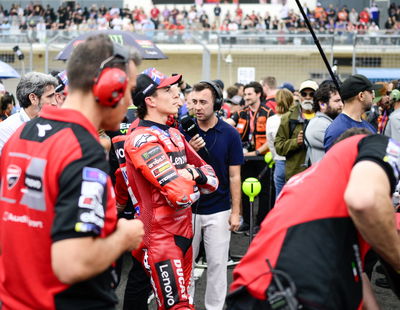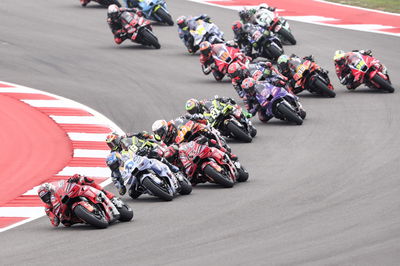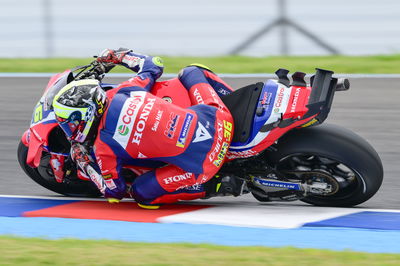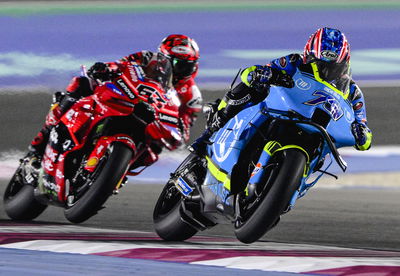Marc Marquez’s COTA MotoGP grid gamble: Wrong reasons, right decision?
Marc Marquez miscalculated the scale of his COTA MotoGP penalty but was a last-minute bike swap still the best strategy?

Marc Marquez may have significantly misjudged the penalty for his dramatic last-minute bike swap at Sunday's COTA MotoGP, but it was still probably the smartest decision in terms of his race strategy.
With rain falling before the sighting lap, most riders - including Marquez - went to the grid on wet tyres. However, as the start approached, it became increasingly clear that slicks were the better choice.
Only three riders - Brad Binder (16th), Enea Bastianini (17th), and Ai Ogura (18th) - had already committed to slicks.
Marquez then ran off the grid to switch to his dry bike just before the warm-up lap, triggering others to follow.
But as newly released footage revealed, the eight-time world champion did so believing he would simply start from the back of the grid.
Instead, Marquez would have started from his original pole position but then had to serve a ride-through penalty in the race. A much harsher punishment.
Despite that misunderstanding, was leaving the grid for slicks still the best move?
Here are some possible scenarios for those on the grid with wet tyres...
Scenario 1: Leave the grid before warm-up lap and swap to dry bike
- Race start: Normal grid position
- Penalty: Ride-through during the race (approx. 30 seconds lost)
This is exactly what Marquez and others attempted before the start was delayed, on safety grounds, due to the resulting chaos.
Since he made the switch before the warm-up lap, Marquez would have escaped a pit lane start. In fact, he was already waiting at the end of pit lane for the warm-up lap to begin when the race was officially delayed.
Instead of starting from the back of the grid as he believed, Marquez would have lined up in his original pole position - but then had to serve a costly ride through penalty during the race.
That’s a much bigger penalty than he expected, especially since, with others following him in changing bikes, Marquez would not have been ‘last’ on the grid.
Nonetheless, providing his slick bike would be quicker than the wet bike from lap one, it might still have been the least damaging option for Marquez (and others with wet tyres on the grid) in terms of time lost.
Scenario 2: Leave grid and swap to dry bike after the warm-up lap.
- Race start: End of pit lane.
- Penalty: Ride-through during the race (approx. 30 seconds lost)
If Marquez had stayed on the grid with wet tyres for the warm-up lap and then pitted to change bikes, he would have started the race from the end of pit lane and had a ride-through penalty to serve in the race.
This scenario would have been worse than Scenario 1 because it would have added extra time lost at the start, while waiting for the pack to pass before being released from the end of pit lane.
Scenario 3: Start on wets, then change to dry bike during the race (flag to flag).
- Race start: Normal grid position.
- Penalty: No ‘penalty’ but bike swap equivalent to a ride-through plus several seconds.
To avoid a penalty, Marquez would have needed to stick with his wet bike for the race start and then pit for the dry bike (flag to flag).
However, a bike swap in the pits costs slightly more time than a ride-through penalty, because the rider has to jump off one bike and onto another.
This strategy would only have been worthwhile if wet tyres had been faster than slicks for the opening laps - allowing Marquez to build a lead before pitting - something that seems unlikely in Sunday’s fast-drying conditions.

Where might Marquez have finished?
If the original race start had gone ahead and Marquez had taken his place on pole before serving a ride-through penalty, where might he have finished?
Since Marquez crashed out of the lead of the ‘restart’, (held slightly later when the track was even dryer and over 19 instead of the original 20 laps) we don’t know what Marquez’s pace would have been over a race distance on slicks.
But we can look at the performance of two riders on the original grid with slicks and compare them to race winner Francesco Bagnaia.
- Bastianini (started 17th, finished 7th) +12.815s behind Bagnaia
- Ogura (started 18th, finished 9th) +16.344s behind Bagnaia
- Binder (started 16th, retired from 5th with a technical issue)
If we assume the ride-through would have cost Marquez 30-seconds, it looks extremely difficult for him to then catch Binder, Bastianini or Ogura for pure pace.
However, with the rest of the field either starting on wets (and soon struggling) or also facing a ride-through penalty, Marquez could have been ‘best of the rest’ - fighting for at least fourth place.
In other words, his perfect 2025 win streak was effectively over when he arrived on the grid with his wet bike... until the start was delayed.
Who Were the Real Losers?
If the race had started as planned, Marquez's dramatic grid exit would probably still have been the best damage limitation option available.
However, the three riders who originally committed to slicks - Binder, Bastianini, and Ogura - were the biggest losers.
By delaying the start, all riders were allowed to change bikes and their advantage erased, meaning they suffered the most from Sunday’s chaotic scenes.












